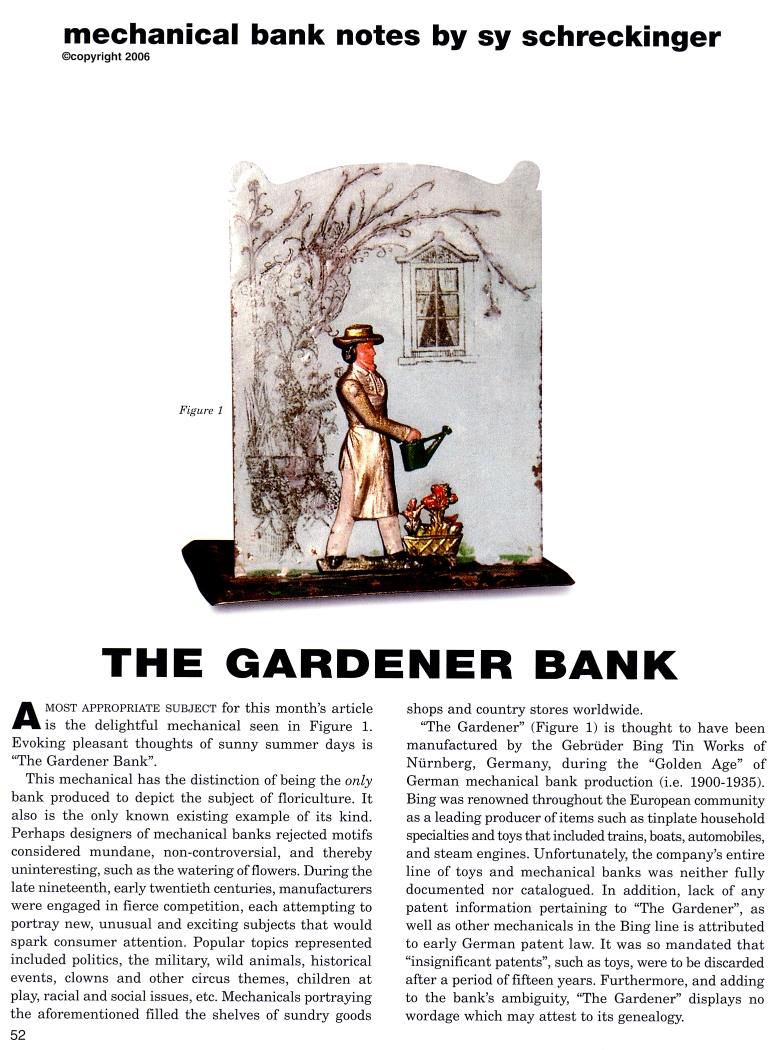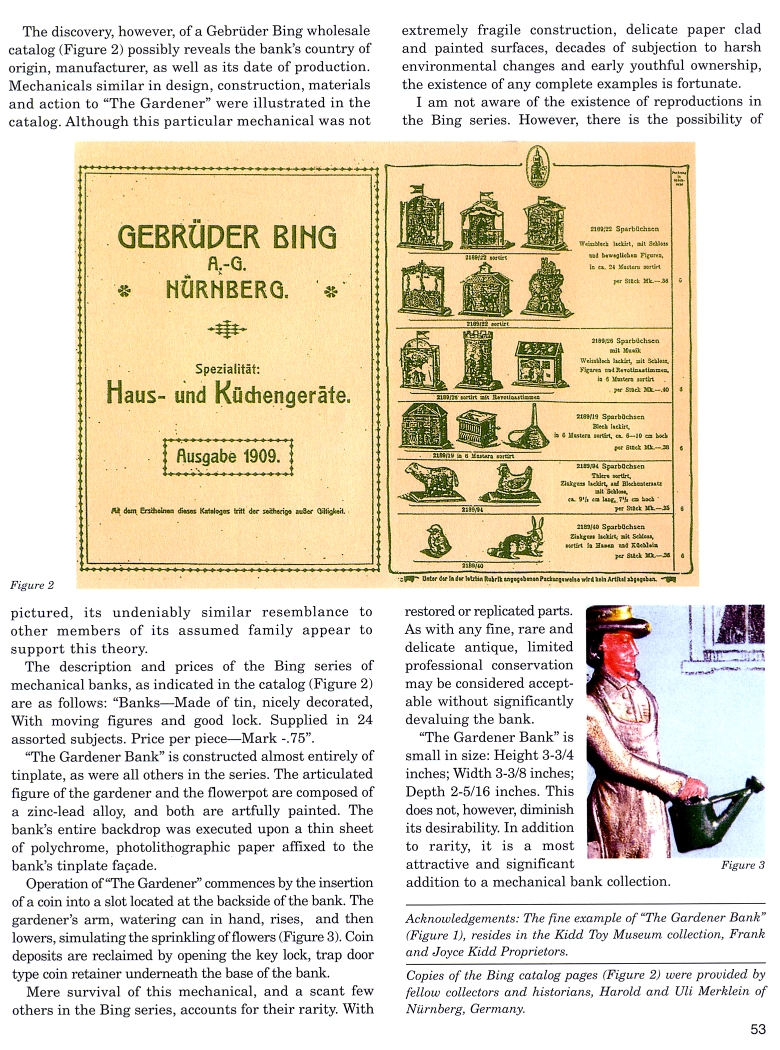|
The Gardener Bank
by Sy Schreckinger – ANTIQUE TOY WORLD Magazine – August, 2006
A most appropriate subject for this month's
article is the delightful mechanical seen in Figure 1. Evoking pleasant
thoughts of sunny summer days is "The Gardener Bank".
This mechanical has the distinction of being the only bank produced
to depict the subject of floriculture. It also is the only known existing
example of its kind. Perhaps designers of mechanical banks rejected motifs
considered mundane, non-controversial, and thereby uninteresting, such as
the watering of flowers. During the late nineteenth, early twentieth
centuries, manufacturers were engaged in fierce competition, each
attempting to portray new, unusual and exciting subjects that would spark
consumer attention. Popular topics represented included politics, the
military, wild animals, historical events, clowns and other circus themes,
children at play, racial and social issues, etc. Mechanicals portraying
the aforementioned filled the shelves of sundry goods shops and country
stores worldwide.
"The Gardener" (Figure 1) is thought to have been manufactured by the Gebruder Bing Tin Works of Nurnberg, Germany, during the "Golden Age" of
German mechanical bank production (i.e. 1900-1935). Bing was renowned
throughout the European community as a leading producer of items such as
tinplate household specialties and toys that included trains, boats,
automobiles, and steam engines. Unfortunately, the company's entire line
of toys and mechanical banks was neither fully documented nor catalogued.
In addition, lack of any patent information pertaining to "The Gardener",
as well as other mechanicals in the Bing line is attributed to early
German patent law. It was so mandated that "insignificant patents", such
as toys, were to be discarded after a period of fifteen years.
Furthermore, and adding to the bank's ambiguity, "The Gardener" displays
no wordage which may attest to its genealogy.
The discovery, however, of a Gebruder Bing wholesale catalog (Figure
2) possibly reveals the bank's country of origin, manufacturer, as well as
its date of production. Mechanicals similar in design, construction,
materials and action to "The Gardener" were illustrated in the catalog.
Although this particular mechanical was not pictured, its undeniably
similar resemblance to other members of its assumed family appear to
support this theory.
The description and prices of the Bing series of mechanical banks, as
indicated in the catalog (Figure 2) are as follows: "Banks — Made of tin,
nicely decorated, With moving figures and good lock. Supplied in 24
assorted subjects. Price per piece — Mark -.75".
"The Gardener Bank" is constructed almost entirely of tinplate, as
were all others in the series. The articulated figure of the gardener and
the flowerpot are composed of a zinc-lead alloy, and both are artfully
painted. The bank's entire backdrop was executed upon a thin sheet of
polychrome, photolithographic paper affixed to the bank's tinplate facade.
Operation of "The Gardener" commences by the insertion of a coin into
a slot located at the backside of the bank. The gardener's arm, watering
can in hand, rises, and then lowers, simulating the sprinkling of flowers
(Figure 3). Coin deposits are reclaimed by opening the key lock, trap door
type coin retainer underneath the base of the bank.
Mere survival of this mechanical, and a scant few others in the Bing
series, accounts for their rarity. With extremely fragile construction,
delicate paper clad and painted surfaces, decades of subjection to harsh
environmental changes and early youthful ownership, the existence of any
complete examples is fortunate.
I am not aware of the existence of reproductions
in the Bing series. However, there is the possibility of restored or
replicated parts. As with any fine, rare and delicate antique, limited
professional conservation may be considered acceptable without
significantly devaluing the bank.
"The Gardener Bank" is small in size: Height 3-3/4 inches; Width
3-3/8 inches; Depth 2-5/16 inches. This does not, however, diminish its
desirability. In addition to rarity, it is a most attractive and
significant addition to a mechanical bank collection.
Acknowledgements: The fine example of "The Gardener Bank" (Figure 1),
resides in the Kidd Toy Museum collection, Frank and Joyce Kidd
Proprietors.
Copies of the Bing catalog pages (Figure 2) were provided by fellow
collectors and historians, Harold and Uli Merklein of Nurnberg, Germany.
|

